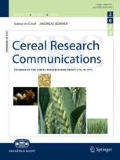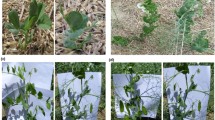Summary
In Hungary in the last few years there has been a renewed interest in improving oil and/or protein content of the soybean crop, because these components have positive economic values both for the purchasers and the sellers. For this purpose mutant soybean germplasm was developed by pedigree method from a Kárpátalja local variety by 100–300 Gy chronical gamma irradiation to produce mutant soybean lines with an increased oil and/or protein content and acceptable agronomic performance. Chronical gamma irradiation increased the genetic variability of the oil content. In the M4 generation, function index predicted up to 28% oil content in the irradiated Kárpátalja germplasm. Plants with 24.1 and 23.6% oil content were selected from the 150 Gy and the 100 Gy populations. Due to the limited genetic variation for protein content, no mutant genotypes with higher protein content were identified. In the M5 generation, progenies of a superior plant with 23.6% oil content were homozygous for this characteristics, while progenies of a superior plant with 24.1% oil content were segregating. Their oil content ranged from 20.3 to 22.1%. Oil content had a moderate negative correlation with 1000-seed weight in both of the studied generations (r = −0.40*** and −0.39***). The 200 Gy dose significantly increased the number of pods, the number of seeds and the yield per plant. The applied doses, except the 150 and the 200 Gy ones, significantly decreased the 1000-seed weight as compared to the control. A function index was introduced to evaluate the genetic variability. The seed yield performance at two locations showed significant differences.
Similar content being viewed by others
References
Dahmer, M.L., P.D. Fleming, G.B. Collins and D.F. Hildebrand. 1989. A rapid screening technique for determining the lipid composition of soybean seeds. J. Am. Oil Chem. Soc. 66:543–548.
Mendenhall, W. 1987. Introduction to probability and statistics, 7th edition. PWS-Kent Publishing Company, Boston
Orf, J.H. and T.C. Helms. 1994. Selection to maximize gross value per hectare within three soybean populations. Crop Sci. 34:1163–1167.
Sagel, Z., A.S. Atila and M.I. Tutluer. 1995. Characteristics of improved mutant varieties in soybean (Glycine max (L) Merill). FAO/IAEA Int. Symp. Use of Induced Mutations and Molecular Techniques for Crop Improvement. IAEA. Vienna., pp.160–164.
Wang, L. and H. Licheng. 1995. Breeding for new spring soybean cultivar Heinong 35 with high protein content and high yield and problems on soybean breeding for dwarf and other mutants. Sci. Agr. Sinica 28, 38–45.
Williams, J.H. and D.G. Hanway. 1961. Genetic variation in oil and protein content of soybeans induced by seed irradiation, Crop Sci. 1: 34–36.
Author information
Authors and Affiliations
Rights and permissions
About this article
Cite this article
Novák, M.H., Kőrösi, F. Mutants obtained by chronical gamma irradiation from a Kárpátalja local soybean variety: II. M4 and M5 generations. CEREAL RESEARCH COMMUNICATIONS 29, 215–220 (2001). https://doi.org/10.1007/BF03543663
Received:
Accepted:
Published:
Issue Date:
DOI: https://doi.org/10.1007/BF03543663



